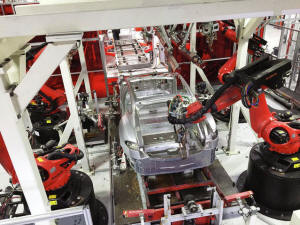|
Tesla’s big Model 3 bet rides on risky
assembly line strategy
 Send a link to a friend
Send a link to a friend
 [April 24, 2017]
By Alexandria Sage [April 24, 2017]
By Alexandria Sage
(Reuters) - Tesla Inc <TSLA.O> Chief
Executive Elon Musk took many risks with the technology in his company's
cars on the way to surpassing Ford Motor Co's market value. Now Musk is
pushing boundaries in the factory that makes them.
Most automakers test a new model's production line by building vehicles
with relatively cheap, prototype tools designed to be scrapped once they
deliver doors that fit, body panels with the right shape and dashboards
that don't have gaps or seams.
Tesla, however, is skipping that preliminary step and ordering
permanent, more expensive equipment as it races to launch its Model 3
sedan by a self-imposed volume production deadline of September, Musk
told investors last month.
Musk’s decision underscores his high-risk tolerance and willingness to
forego long-held industry norms that has helped Tesla upend the
traditional auto industry. While Tesla is not the first automaker to try
to accelerate production on the factory floor, no other rival is putting
this much faith in the production strategy succeeding.
Musk expects the Model 3 rollout to help Tesla deliver five times its
current annual sales volume, a key target in the automaker's efforts to
stop burning cash.
"He's pushing the envelope to see how much time and cost he can take out
of the process," said Ron Harbour, a manufacturing consultant at Oliver
Wyman.
Investors are already counting on Tesla’s factory floor success, with
shares soaring 39 percent since January as it makes the leap from niche
producer to mass producer in far less time than rivals.

There are caution signs, however. The production equipment designed to
produce millions of cars is expensive to fix or replace if it doesn't
work, industry experts say. Tesla has encountered quality problems on
its existing low-volume cars, and the Model 3 is designed to sell in
numbers as high as 500,000 vehicles a year, raising the potential cost
of recalls or warranty repairs.
"It's an experiment, certainly," said Consumer Reports' Jake Fisher, who
has done extensive testing of Tesla's previous Models S and X. Tesla
could possibly fix errors quicker, speeding up the process, "or it could
be they have unsuspected problems they'll have a hard time dealing
with."
Musk discussed the decision to skip what he referred to as "beta"
production testing during a call last month with an invited group of
investors. Details were published on Reddit by an investor on the call.
.
He also said that “advanced analytical techniques” – code word for
computer simulations - would help Tesla in advancing straight to
production tooling.
Tesla declined to confirm details of the call or comment on its
production strategy.
The auto industry's incumbents have not been standing still. Volkswagen
AG's Audi division launched production of a new plant in Mexico using
computer simulations of production tools – and indeed the entire
assembly line and factory - that Audi said it believed to be an industry
first. That process allowed the plant to launch production 30 percent
faster than usual, Audi said.
An Audi executive involved in the Mexican plant launch, Peter
Hochholdinger, is now Tesla's vice president of production.
MAKING TOOLS FASTER
Typically, automakers test their design with limited production using
lower grade equipment that can be modified slightly to address problems.
When most of the kinks are worked out, they order the final equipment.
[to top of second column] |

Tesla vehicles are being assembled by robots at Tesla Motors Inc
factory in Fremont, California, U.S. on July 25, 2016.
REUTERS/Joseph White/File Photo

Tesla’s decision to move directly to the final tools is in part
because lower grade, disposable equipment known as “soft tooling”
ended up complicating the debut of the problem-plagued Model X SUV
in 2015, according to a person familiar with the decision and
Tesla’s assembly line planning.
Working on a tight deadline, Tesla had no time to incorporate
lessons learned from soft tooling before having to order the
permanent production tooling, making the former's value negligible,
the source said.
"Soft tooling did very little for the program and arguably hurt
things," said the person.
In addition, Tesla has learned to better modify final production
tools, and its 2015 purchase of a Michigan tooling company means it
can make major equipment 30 percent faster than before, and more
cheaply as well, the source said.
Financial pressure is partly driving Tesla’s haste. The quicker
Tesla can deliver the Model 3 with its estimated $35,000 base price
to the 373,000 customers who have put down a $1000 deposit, the
closer it can log $13 billion.
Tesla has labored under financial pressure since it was founded in
2003. The company has yet to turn an annual profit, and earlier this
year Musk said the company was "close to the edge" as it look toward
capital spending of $2-2.5 billion in the first half of 2017.
Tesla has since gotten more breathing room by raising $1.2 billion
in fresh capital in March and selling a five per cent stake to
Chinese internet company Tencent Holdings Ltd <0700.HK> .

Musk has spoken to investors about his vision of an "alien
dreadnought" factory that uses artificial intelligence and robots to
build cars at speeds faster than human assembly workers could
manage.
But there are limits to what technology can do in the heavily
regulated car business. For example, Tesla will still have to use
real cars in crash tests required by the U.S. government, because
federal rules do not allow simulated crash results to substitute for
data from a real car.
(Editing by Peter Henderson and Edward Tobin)
[© 2017 Thomson Reuters. All rights
reserved.]
Copyright 2017 Reuters. All rights reserved. This material may not be published,
broadcast, rewritten or redistributed. |